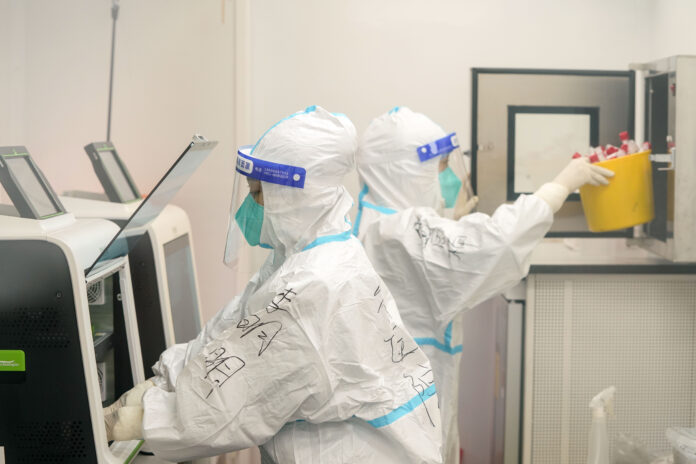Hospitalizations in Ontario
Ontario reported 2,279 people in hospital wards with COVID-19 (up by 198 from the previous day) with 319 patients in intensive care units (up by 31).
Last Thursday, there were 965 hospitalizations with 200 in ICUs.
Hospitalizations and those in ICUs with COVID continue to rise daily as Ontario grapples to contain Omicron. Although Omicron is considered less severe than Delta, the unprecedented surge in cases has driven general hospitalizations to soar at a much faster rate. However, ICU is still rising but at a slower rate when compared to overall hospitalizations.
Staffing shortages due to the new variant have impacted hospitals as the need for beds increases. Non-urgent surgeries have been ordered to pause.
Story continues below advertisement
For comparison, in the third wave peak in April 2021 which was the worst wave for hospitalizations, the province saw almost 2,400 patients in hospital wards and as many as 900 patients in ICUs with COVID among a population that was vastly unvaccinated.
Ontario’s fourth wave is approaching the third wave peak for hospitalizations, but is currently further behind in ICU.
In terms of vaccination status, for those in general hospital wards with COVID, 436 were unvaccinated, 96 were partially vaccinated and 1,156 were fully vaccinated. For patients in ICUs, 123 were unvaccinated while 28 were partially vaccinated and 87 were fully vaccinated.
In population comparison, as the majority of Ontarians are vaccinated, those who are unvaccinated are still far more likely to land in hospital or ICU than the vaccinated. Ontario’s COVID-19 Science Advisory Table indicates fully vaccinated individuals are 80 per cent less likely to end up in hospital and 93 per cent less likely to end up in ICU.
Provincial officials noted this new dataset with vaccination status for hospitalizations will grow and improve over time as more information is collected. There may also be a discrepancy due to how and when the information for both is collected.
Trending Stories
Canada headed for nursing shortage ‘beyond anything we’ve ever experienced’: experts
Feds weighing fines after passengers ditch masks on Sunwing flight to Mexico
Story continues below advertisement
Deaths, vaccinations, recoveries, active cases, 7-day average, testing, test positivity
The death toll in the province has risen to 10,272 as 20 more virus-related deaths were reported.
As of 8 p.m. on Wednesday, there are more than 11.4 million people fully immunized with two doses, which is 88.3 per cent of the aged 12 and older population. First dose coverage stands at 90.9 per cent. Third dose immunization is at 32.7 per cent.
For young children aged five to 11, first dose coverage stands at 44.8 per cent with 2.3 per cent who are now fully vaccinated.
The province administered 195,005 doses in the last day. There are more than 4.2 million Ontarians who have received a booster shot.
Meanwhile, 695,786 Ontario residents were reported to have recovered from COVID-19, which is around 82 per cent of known cases. Resolved cases increased by 12,036 from the previous day.
Story continues below advertisement
Active cases in Ontario now stand at 135,313 — up from last week when it was at 86,754. At the peak of the second wave in January, active cases hit just above 30,000. In the third wave in April, active cases topped 43,000.
The seven-day average has now reached 14,532 as daily case counts due to Omicron continue to hover around unprecedented highs. This is up from 10,328 a week ago.
The government said 59,241 tests were processed in the previous 24 hours. There are 99,870 tests currently under investigation.
Test positivity hit 29.2 per cent meaning more than 1 in 4 tests are coming back positive for COVID. Last week, test positivity was at 30.5 per cent.
However, Ontario officials have recently changed testing eligibility for those seeking to get a PCR test to detect COVID-19 to only the most high-risk populations such as health care, long-term care, those who live and work in congregate settings, etc.
Here is a breakdown of the total cases in Ontario by gender and age:
415,029 people are male — an increase of 5,614 cases.
423,091 people are female — an increase of 7,614 cases.
24,824 people are under the age of four — an increase of 307 cases.
52,834 people are 5 to 11 — an increase of 639 cases.
76,800 people are 12 to 19 — an increase of 1,068 cases.
324,027 people are 20 to 39 — an increase of 5,522 cases.
232,060 people are 40 to 59 — an increase of 3,866 cases.
100,133 people are 60 to 79 — an increase of 1,484 cases.
30,512 people are 80 and over — an increase of 449 cases.
The province notes that not all cases have a reported age or gender.
Here is a breakdown of the total deaths related to COVID-19 by age:
Story continues below advertisement
Deaths reported in ages 19 and under: Nine
Deaths reported in ages 20 to 39: 113 (+2)
Deaths reported in ages 40 to 59: 743 (+2)
Deaths reported in ages 60 to 79: 3,410 (+10)
Deaths reported in ages 80 and older: 5,994 (+6)
The province notes there may be a reporting delay for deaths and data
Cases, deaths and outbreaks in Ontario long-term care homes
According to the Ontario Ministry of Long-Term Care, there have been 3,844 deaths reported among residents and patients in long-term care homes across Ontario, which is an increase of five deaths since the previous day. Thirteen virus-related deaths in total have been reported among staff.
There are 186 current outbreaks in homes, which is up by 41 from the previous day.
The ministry also indicated there are currently 870 active cases among long-term care residents and 1,525 active cases among staff — up by 299 and up by 498, respectively, in the last day.
Story continues below advertisement
© 2022 Global News, a division of Corus Entertainment Inc.



